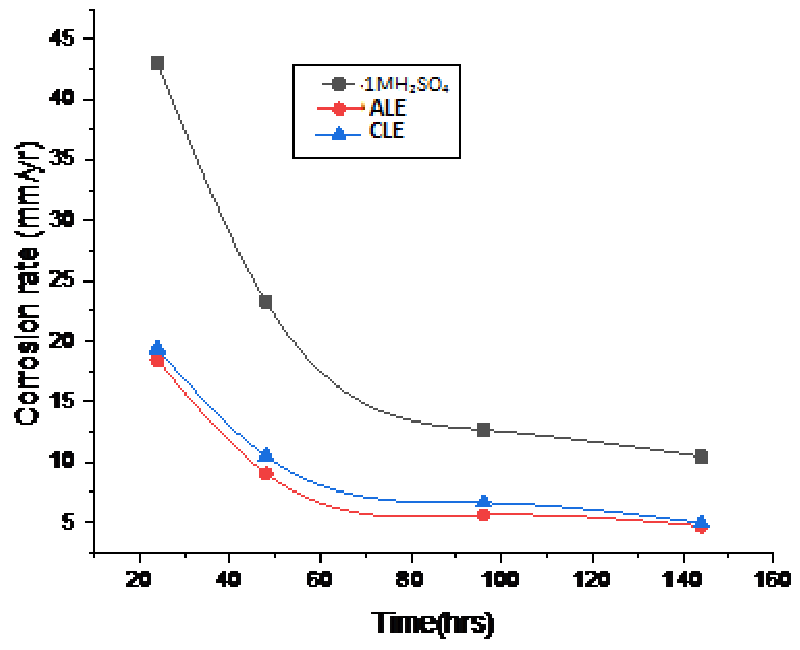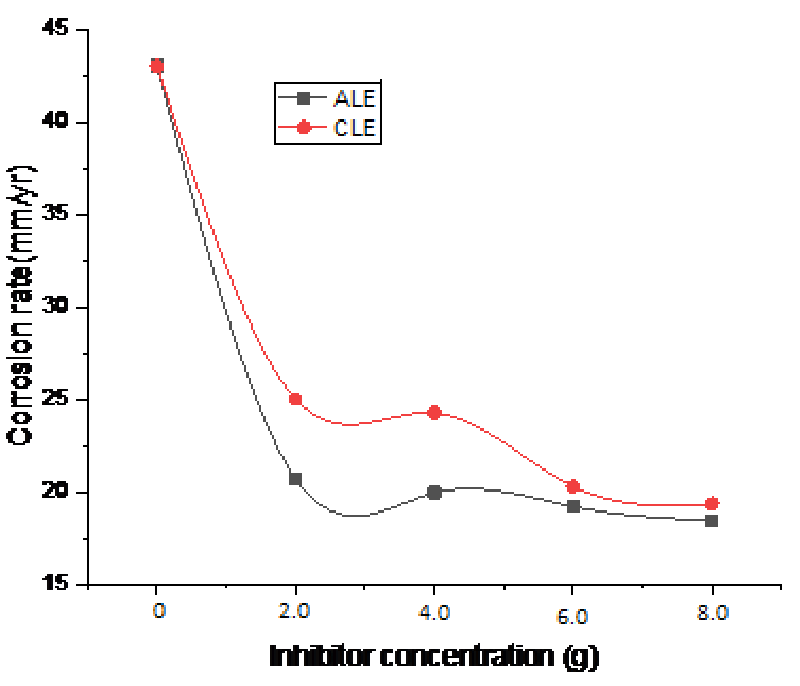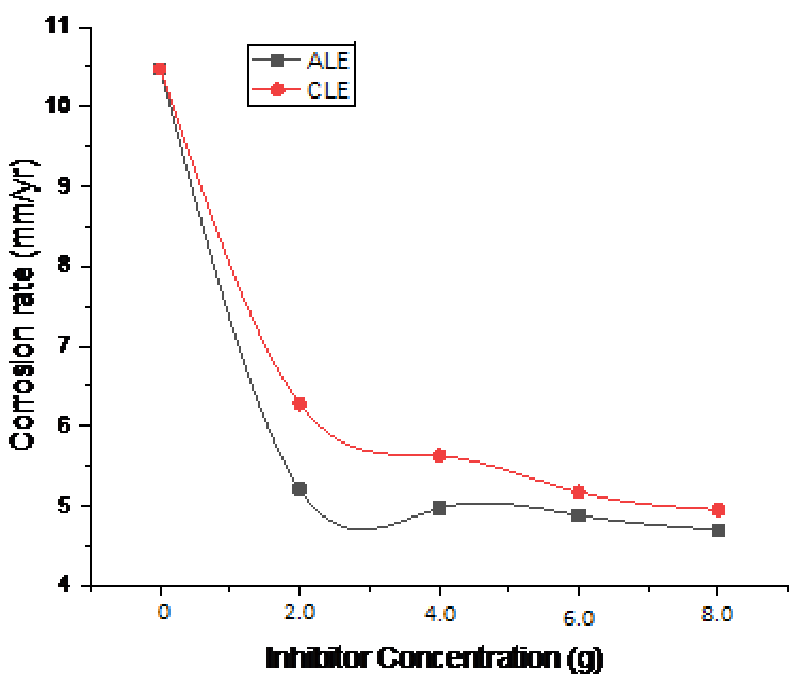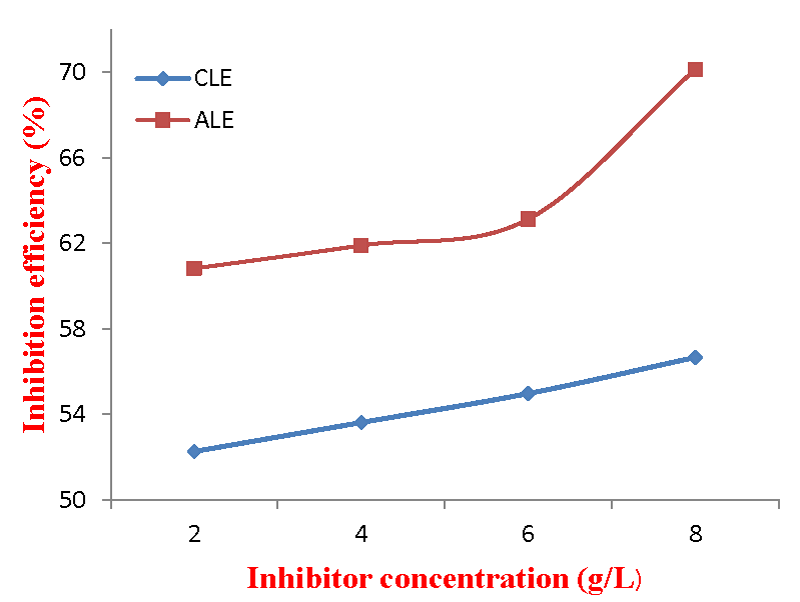Journal of Civil Engineering and Environmental Sciences
Evaluation of corrosion characteristics of mild steel in the acidic environment using Cocoyam and Almond leaves extracts as inhibitors
Christopher N Mbah1, Deborah C Onyeabor1, Bonaventure C Ugwuanyi1, Michael G Anuta1, Chukwunonso S Nebechi1, Obinna L Iyida1 and Kingsley C Nnakwo2*
2Department of Metallurgical and Materials Engineering, Nnamdi Azikiwe University, Awka, Nigeria
Cite this as
Mbah CN, Onyeabor DC, Ugwuanyi BC, Anuta MG, Nebechi CS, et al. (2023) Evaluation of corrosion characteristics of mild steel in the acidic environment using Cocoyam and Almond leaves extracts as inhibitors. J Civil Eng Environ Sci 9(2): 020-024. DOI: 10.17352/2455-488X.000063Copyright License
© 2023 Mbah CN, et al. This is an open-access article distributed under the terms of the Creative Commons Attribution License, which permits unrestricted use, distribution, and reproduction in any medium, provided the original author and source are credited.The inhibition characteristics of Almond and Cocoyam leaves extracts on mild steel immersed in 1 M H2SO4 at immersion times of 24 h to 144 h have been investigated experimentally. The effects of various concentrations of the extracts on the corrosion rate and inhibition efficiency were also explored. The average corrosion rates (in mm yr-1) and inhibition efficiencies (in %) were determined at each extract concentration and immersion time. Results show that both extracts demonstrated excellent inhibition characteristics for mild steel in H2SO4 media as the corrosion rate of the mild steel decreased from 43.0096 mm yr-1 to 4.7019 mm yr-1 and 4.9528 mm yr-1 after adding 8 g/L of Cocoyam and Almond leaves extracts respectively. This can be linked with the adsorption of molecules of oxidative phytochemical constituents of the extracts on the mild steel surfaces which shielded the mild steel surfaces from further attack by the acid. Within the time range of the study, the inhibition efficiency of both Cocoyam and Almond leaves extracts increased with an increase in inhibitor concentration with maximum inhibition efficiencies of 70.15% and 56.67% recorded by Almond and Cocoyam leaves extracts respectively at concentrations of 8 g/L. Conclusively, Almond leaves extracts are better mild steel corrosion inhibitors than cocoyam leaves extracts, due to the lower pH value of Cocoyam leaf extract.
Introduction
Mild steel has gained wide applications in oil, marine, and automobile industries for the fabrication of pipelines, construction of bridges, and automobile parts considering its excellent mechanical properties. But due to the corrosive nature of mild steel, it becomes pertinent to explore metallurgical means of mitigating their rate of corrosion to avoid catastrophic failure of components. This development forms the rationale for choosing mild steel for this experimental study. Corrosion inhibitors are substances that can be added to corrosive environments to reduce the rate of corrosion. Traditional corrosion inhibitors are often synthetic chemicals, but researchers have been exploring natural compounds as potential alternatives due to their eco-friendly nature and low toxicity [1]. Plant extracts contain naturally occurring compounds such as tannins, alkaloids, flavonoids, phenols, and organic acids that have been found to possess inhibitive properties against corrosion. The active compounds in plant extracts can form a protective film on the metal surface, which acts as a barrier against corrosive agents. This film can inhibit the access of oxygen, moisture, and corrosive ions to the metal surface, thus reducing the corrosion rate. The use of plant extracts as corrosion inhibitors offers a greener and more sustainable approach compared to traditional chemical inhibitors. Plant extracts are generally non-toxic, biodegradable, and readily available. The effectiveness of plant extracts as corrosion inhibitors can vary depending on factors such as concentration, pH, temperature, and the specific metal being protected [2].
The main objective of this research is to explore the potentiality of Almond and Cocoyam leaves extracts for inhibition of mild steel corrosion in a highly corrosive environment; 1 M H2SO4 solution. This research is quite significant as it provides information on the wider application and economic values of green plants for effective corrosion control of mild steel in industries. This development will significantly boost the economy of the country due to waste reduction, cost-effectiveness, recyclability of agricultural wastes, and effective corrosion inhibition in industries.
Recent studies explored the inhibition performances of various eco-friendly plants extracts of Rheum Ribes flower [1], Rubia tinctorum root [2], Hemigraphis colorata leaves [3], Passiflora edulis Sims peels [4], Rheum ribes leaf [5], Camellia chrysantha flower [6], Chromolaena Odorata leaf [7], garlic [8], Dysphania ambrosioïdes leaf [9], rice straw [10], Etlingera Elatior inflorescence [11], Pulicaria undulate [12], Vicia Sativa weed aerial [13], Malpighia glabra leaf [14], Cnicus Benedictus weed [15], Eruca sativa seed [16], Irvingia gabonensis and wombolu [17,18]. Kaya, et al. (2023) in their recent study of the effectiveness of Rheum Ribes flower as a potential corrosion inhibitor for mild steel in 1 M HCl solution, recorded 94.7 % and 98.4 % inhibition efficiencies at 1000 ppm concentration for 1 h and 6 h immersion times respectively. The study (Kaya, et al. 2023) revealed the extract as a mixed inhibitor. The high inhibition efficiencies are linked to the effective interaction of the molecules. Marsoul, et al, [2] explored the inhibitive characteristics of Rubia tinctorum root. And recorded optimum inhibition efficiency of 95% at 1 g/L and 298 K. Other plant extracts [3-16] demonstrated excellent inhibition performances with optimum efficiencies in the range of 65.13% - 94.9%. Irvingia gabonensis and wombolu recorded inhibition efficiencies of 93.33% and 97.87% respectively [17,18]. Green plant extracts have been revealed as a potential alternative to industrial inhibitors for a sustainable eco-friendly environment [19-40].
This study was propelled by the recent demands to expand the economic values of eco-friendly agricultural wastes in Nigeria and effectively mitigate the high rate of corrosion of mild steel in industries.
Methodology
Coupon preparation
Coupons of dimensions 3 cm x 4 cm x 0.05 cm used for this present study were prepared from a rectangular mild steel bar sourced from New Kenyatta Market Enugu, Nigeria. The coupon surfaces were ground and polished using an electric grinder (ZMAK-GA5030/2), silicon carbide papers of grit sizes; 220, 400, and 600µm, and pure aluminum powder. The polished coupons were degreased with acetone, dried using a Bosch GHG660LCD heat gun machine, and stored in moisture-free desiccators prior to use.
Sourcing and preparation of cocoyam leaf extract
The fresh Almond and cocoyam leaves used for this experimental study were sourced from Independent Layout, Enugu State, Nigeria. The Cocoyam and Almond leaves were washed properly with distilled water, sliced, and dried at 25 oC for two weeks. Subsequently, the leaves were ground using an SB-1872 electric blender. Soxhlet extraction was performed on the homogenized samples using ethanol as a solvent. The Soxhlet extraction process was carried out at 60 oC. About 1000 g samples were wrapped in a Whatman paper placed in a cellulose extraction thimble and extracted with the solvent for 6 hours at 6 cycles per hour. About 40 g of Almond and cocoyam leaf extracts were obtained out of which 2 g, 4 g, 6 g, and 8 g were measured using a BL20001 electronic compact scale and dissolved into 1.0 L of 1 M H2SO4 solution.
Weight loss measurement
Weight loss measurement was adopted for the measurement of the corrosion rates for each concentration of extract. The prepared coupons were immersed in 1 M H2SO4 solution with and without the extract. The corrosion rates of the mild steel in 1 M H2SO4 with and without extracts additions were measured after 24 h, 48 h, 96 h, and 144 h immersion times at a temperature of 25 oC. The pH values of the solutions with and without extract additions are presented in Table 1. The coupons were rinsed, swabbed in acetone, and dried using a Bosch GHG660LCD heat gun machine after each immersion time. The weight of the coupons before and after immersion was measured using a BL20001 electronic compact scale. The corrosion rate and inhibition efficiency of four samples per extract concentration were calculated using equations 1 and 2 respectively and average values were recorded.
Where Cr is the corrosion rate (in mm/yr), Wi-Wii is the change in weight of the sample before and after immersion (in gram), y is the cross-sectional area of the specimen ( in mm2), t is the immersion time (in h) and ρ is the density of the sample (in g/mm3).
Where ε is the inhibition efficiency, Cro is the corrosion rate without extract addition, and Cri is the corrosion rate with extract addition.
Results
Figures 1-4 show the results obtained from the experimental study. The corrosion rates of the mild steel with and without extracts additions are presented in Figures 1-3, while the inhibition efficiencies of the Almond and Cocoyam leaf extracts are presented in Figure 4.
Discussion
Figure 1 depicts the comparative analysis of the corrosion rate of mild steel immersed in 1 M H2SO4 with and without extract additions. From Figure 1, it can be observed that the corrosion rate of mild steel in 1 M H2SO4 containing no extract is higher compared with extract additions. Additions of Almond leaves and Cocoyam leaves extracts significantly decreased the rate of corrosion, with predominant effects recorded by Almond leaf extract. At each condition, it is noted that the corrosion rate decreased correspondingly with increasing immersion times. This can be linked with the adsorption of molecules of extracts in the mild steel surfaces which shielded the mild steel surfaces from further attack by the acid. Figures 2 and 3 show the effects of Almond leaves (AL) and Cocoyam leaves (CL) extract concentrations on the corrosion rate of mild steel in 1 M H2SO4. It is noted from Figures 2 and 3 that the corrosion rate decreased significantly with the addition of both extracts. The corrosion rate decreased correspondingly with an increase in the concentrations of the extracts. Figure 4 shows the inhibition characteristics of the Almond and Cocoyam leaves extracts at different concentrations at 24 h immersion time. Analysis of Figure 4 shows that both Almond and Cocoyam leaves extracts recorded inhibition efficiencies of 70.15% and 56.67% respectively. The maximum inhibition efficiency recorded by Almond leaf extracts can be linked with the higher pH value of the extract compared with that of Cocoyam leaf extract. From the results obtained, it is obvious that both Almond and Cocoyam leaves extracts are potential inhibitors for mild steel corrosion mitigation in 1 M H2SO4 solution. This development has provided information on the wider application and economic values of green plants for economic development and adequate waste reduction, cost-effectiveness, and recyclability of agricultural wastes.
Comparative analysis of inhibition potentials of Almond and Cocoyam leaves extracts with conventional green plants inhibitors
Table 2 shows the comparative analysis of inhibition efficiencies of different green plant extracts. It is shown that the present studied green plant extracts recorded lower inhibition efficiencies compared with some earlier studied green plant extracts. Almond leaves extract recorded higher inhibition efficiency than Date palm seed extract [19].
Conclusion
The inhibition characteristics of Almond and Cocoyam leaves extracts on mild steel immersed 1 M H2SO4 for 24, 48, 96 and 144 h immersion times have been investigated experimentally. The effects of various concentrations of the extracts on the corrosion rate and inhibition efficiency were also explored. From the results obtained, the Almond and Cocoyam leaf extracts demonstrated excellent inhibition potential in 1 M H2SO4 solution at various extract concentrations and immersion times at 25 oC. Almond leaves extract recorded better corrosion resistance and inhibition efficiency compared with Cocoyam leaves extracted due to higher pH values of the extract concentration in 1 M H2SO4 solution. Maximum inhibition efficiencies of 70.15% and 56.77% were recorded by Almond and Cocoyam leaves extracts of 8 g/L concentrations and immersion time of 144 h at 25 oC. Conclusively, Cocoyam and Almond leaves extracts have been established as potential inhibitors for corrosion mitigation of mild steel in 1 M H2SO4 solution, hence can be recommended for industrial applications. Further study on the corrosion inhibition potential of both extracts at higher temperatures is recommended.
The authors are delighted and sincerely appreciate Engr. Prof. C. N. Mbah for his technical and professional input in this research work.
- Fatma K, Solmaz R, Geçibesler İH. The Use of Methanol Extract of Rheum Ribes (Işgın) Flower as a Natural and Promising Corrosion Inhibitor for Mild Steel Protection in 1 M HCl Solution. Journal of Industrial and Engineering Chemistry. 2023.
- Marsoul A. Phytochemical Characterization, Antioxidant Proprieties and Electrochemical Investigations of Methanolic Extract of Rubia t.L. Roots for LC-Steel Corrosion Protection in 1 M HCl Medium. Journal of Bio- and Tribo-Corrosion. 2023; 9.2.
- Supriya B, Vijaya DP Alva, Sannaiah PN. Hemigraphis Colorata (HC) Leaves Extract as Effectual Green Inhibitor for Mild Steel Corrosion in 1M HCl. Biointerface Research in Applied Chemistry. 2023; 13.2.
- Bilan L. Passiflora Edulis Sims Peel Extract as a Renewable Corrosion Inhibitor for Mild Steel in Phosphoric Acid Solution. Journal of Molecular Liquids. 2023; 375: 121296.
- Kaya F, Solmaz R, Gecibesler IH. Investigation of Adsorption, Corrosion Inhibition, Synergistic Inhibition Effect and Stability Studies of Rheum Ribes Leaf Extract on Mild Steel in 1 M HCl Solution. Journal of the Taiwan Institute of Chemical Engineers. 2023; 143.
- Dai J, An X. Corrosion Inhibition Properties Of Camellia Chrysantha Flower Extract for Q235 in 1 M HCl Solution. International Journal of Electrochemical Science. 2023; 18.
- Ernest ME, Chinedu AP. Assessment of the Corrosion Inhibitory Potentials of Chromolaena Odorata Leaf Extract on Mild Steel in Hydrogen Chloride Acid Environment. Moroccan Journal of Chemistry. 2023;11.1:188–204.
- Mohamed RNS, Ahmed ZW. Effect of Garlic Extract as Corrosion Inhibitor for Copper in Acidic Medium.” Eurasian Chemical Communications. 2023; 5.1: 28–36.
- Ouassima R. Experimental and Quantum Studies of Dysphania Ambrosioïdes (L.) as Ecological Corrosion Inhibitor for Mild Steel in Hydrochloric Acid Environment. Journal of Bio- and Tribo-Corrosion. 2022; 8.4.
- Olamide O. Anti-Corrosion Using Rice Straw Extract for Mild Steel in 1.5 M H2SO4 Solution. Results in Engineering. 2022; 16.
- Nabila RS, Othman NK. Gravimetric and electrochemical test of etlingera elatior inflorescence extract as green corrosion inhibitor. Jurnal Teknologi. 2022; 84.6–2: 95–103.
- Ezzat A, Abdel Motaal SM, Ahmed AS, Sallam HB, El-Hossiany A, Fouda AEAS. Corrosion Inhibition of Carbon Steel in 2.0m HCl Solution using Novel Extract (pulicaria undulate). Biointerface Research in Applied Chemistry. 2022; 12: 6415–6427.
- Abhinay T. Experimental, DFT and MC Simulation Analysis of Vicia Sativa Weed Aerial Extract as Sustainable and Eco-Benign Corrosion Inhibitor for Mild Steel in Acidic Environment. Sustainable Chemistry and Pharmacy. 2022; 29.
- Vuong BX. Corrosion Inhibition of Carbon Steel in Hydrochloric Acid Solution by Self-Formation of a Malpighia Glabra Leaf Extract-Based Organic Film. Materials Today Communications. 2022; 31.
- Abhinay T. Computational and Experimental Studies on the Corrosion Inhibition Performance of an Aerial Extract of Cnicus Benedictus Weed on the Acidic Corrosion of Mild Steel. Process Safety and Environmental Protection. 2022; 161:801–818.
- Gadow HS, Fakeeh M. Green Inhibitor of Carbon Steel Corrosion in 1 M Hydrochloric Acid: Eruca Sativa Seed Extract (Experimental and Theoretical Studies). RSC Advances. 2022; 12.15:8953–8986.
- Cynthia OC, Mbah CN, Nnakwo KC. Inhibitive Characteristics of Irvingia Gabonensis Extract on Mild Steel Corrosion in Hydrochloric Acid. American Journal of Chemistry and Materials Science. 2019; 6:15-20.
- Nwankwo MC, Onah CC, Nnakwo KC. Effectiveness of Irvingia Wombolu Extract on Corrosion Inhibition of Mild Steel in Hydrochloric Acid Solution.” Engineering Research Express. 2020; 2.1:015039.
- Ahmad MF, Mohammed NJ, Othman NK. Electrochemical Studies of Date Palm Seed as a Green Corrosion Inhibitor for Carbon Steel in 0.5 M H2SO4 and CH3COOH Conditions. Lecture Notes in Mechanical Engineering. Springer Science and Business Media Deutschland GmbH. 2023; 239–246.
- Du P. Shuduan D, Xianghong L. Mikania Micrantha Extract as a Novel Inhibitor for the Corrosion of Cold Rolled Steel in Cl2HCCOOH Solution. Journal of Materials Research and Technology. 2022; 19: 2526-2545.
- Feng L. Cucumber (Cucumis Sativus L.) Leaf Extract as a Green Corrosion Inhibitor for Carbon Steel in Acidic Solution: Electrochemical, Functional and Molecular Analysis. Molecules. 2022; 27:12.
- Golafshani MG. MD and DFT Computational Simulations of Caffeoylquinic Derivatives as a Bio-Corrosion Inhibitor from Quince Extract with Experimental Investigation of Corrosion Protection on Mild Steel in 1M H2SO4. Journal of Molecular Structure. 2023; 1275.
- Li X. Inhibition Effect of Bamboo Leaves Extract on Cold Rolled Steel in Cl3CCOOH Solution. Journal of Materials Research and Technology. 2017; 6: 158–170.
- Tang M. Synergistic Inhibition Effect of Mikania Micrantha Extract with KI on Steel Corrosion in H2SO4 Solution. Journal of Molecular Liquids. 2021; 344.
- Tang M. Mikania Micrantha Extract/KI Blend as a Novel Synergistic Inhibitor for Steel Corrosion in Concentrated H3PO4 Solution. Industrial Crops and Products. 2023; 193.
- Wei G, Shuduan D, Xianghong L. Eupatorium Adenophora (Spreng.) Leaves Extract as a Highly Efficient Eco-Friendly Inhibitor for Steel Corrosion in Trichloroacetic Acid Solution. International Journal of Electrochemical Science. 2022; 17.
- Zhang F. Alternanthera Philoxeroides Extract as a Corrosion Inhibitor for Steel in Cl3CCOOH Solution. International Journal of Electrochemical Science. 2023; 18: 100057.
- Thakur A, Ashish K. Sustainable Inhibitors for Corrosion Mitigation in Aggressive Corrosive Media: A Comprehensive Study. Journal of Bio- and Tribo-Corrosion. 2021.
- Thakur A. Recent Advancements in Surface Modification, Characterization and Functionalization for Enhancing the Biocompatibility and Corrosion Resistance of Biomedical Implants. Coatings. 2022.
- Hijazi KM. Comparative Study of the Effect of an Acidic Anion on the Mild Steel Corrosion Inhibition Using Rhus Coriaria Plant Extract and Its Quercetin Component. Portugaliae Electrochimica Acta. 2021; 39: 237-252.
- Mwakalesi AJ. Corrosion Inhibition of Mild Steel in Sulphuric Acid Solution with Tetradenia Riparia Leaves Aqueous Extract: Kinetics and Thermodynamics. Biointerface Research in Applied Chemistry. 2023; 13..
- Omran MA. Optimization of Mild Steel Corrosion Inhibition by Water Hyacinth and Common Reed Extracts in Acid Media Using Factorial Experimental Design.Green Chemistry Letters and Reviews. 2022; 214–230.
- Saxena A. Use of Saraca Ashoka Extract as Green Corrosion Inhibitor for Mild Steel in 0.5 M H2SO4. Journal of Molecular Liquids. 2018; 258: 89–97.
- Katuwal P. Assessment on the Effective Green-Based Nepal Origin Plants Extract as Corrosion Inhibitor for Mild Steel in Bioethanol and Its Blend. European Journal of Advanced Chemistry Research. 2020; 1.
- Ade SB. Inhibiting Effect of Natural Plant Leaves Extract Used as Green Corrosion Inhibitor for Mild Steel in Acidic Media. International Journal for Research in Applied Science and Engineering Technology. 2022; 10: 136-147.
- Al Maofari A. Inhibition Study of Various Extracts of Tribulus Terrestris Plant on the Corrosion of Mild Steel in a 1.0 m Hcl Solution. Portugaliae Electrochimica Acta. 2021; 39: 21–35.
- Sultan EB. Cynodon Dactylon L. Extract as an Eco-Friendly Corrosion Inhibitor of Mild Steel in Saline Solution. Journal of Pharmacy & Bioresources. 2022; 19: 51–57.
- Fekkar G. Eco-Friendly Chamaerops Humilis l. Fruit Extract Corrosion Inhibitor for Mild Steel in 1 M HCL. International Journal of Corrosion and Scale Inhibition. 2020; 9: 446-459.
- Uwah IE, Okafor PC, Ebiekpe VE. Inhibitive Action of Ethanol Extracts from Nauclea latifolia on the Corrosion of Mild Steel in H2SO4 Solutions and Their Adsorption Characteristics. Arabian Journal of Chemistry. 2013; 6: 285-293.
- Mbah CN. Green Corrosion Inhibition Performance of Orange Leaves Extract on Mild Steel Sheet Buried in an Acidified Soil. International Journal of Research in Advanced Engineering and Technology. 2023; 9: 24-27.
Article Alerts
Subscribe to our articles alerts and stay tuned.
 This work is licensed under a Creative Commons Attribution 4.0 International License.
This work is licensed under a Creative Commons Attribution 4.0 International License.






 Save to Mendeley
Save to Mendeley
